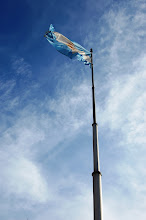Welcome back! Hopefully the Guia-T introduction was helpful and you found a bus that can take you where you want to go (without too much flipping fatigue!) Once you find the bus stop, the hard part’s over! The only thing left to do is wait until said bus shows up and get on, right? Well, sure you could do that, but unless you follow some simple bus stop rules, people are going to know you’re a tourist and that’s never good (makes you more of a target for pick-pockets, for one thing). It doesn’t require a trip to Madame Defarge’s School of Deportment, but behavior at bus stops is governed by a implicit set of rules that, once you know them, are easy to follow and will make colectivo-riding much smoother (though not literally, the roads are still covered in potholes and suspensions are practically nonexistent—more like trampolines than floorboards).
First, LINES. If you approach a bus stop and there is a line of people waiting, you must go to the end of the line. This is common sense, but you’d be surprised. If there is more than one bus route number listed on the pole, as often happens along the main avenidas (Santa Fe, Puerreydon, Corrientes, Córdoba, Rivadavia, Cabildo, Belgrano, etc), there will still only be ONE line of people. This is important to note as it affects the next step: flagging.
FLAGGING a bus down is obviously a crucial step, because the bus will NOT stop automatically at every bus stop. The drivers (colectiveros) are operating a kind of mass chauffeur service, and will only stop when signaled, either by someone on the bus who would like to get off (bajar = to get off), or by someone on the ground who would like to get on (subir = to get on). So, unless you signal the driver to stop, he will thunder right past, leaving you choking on his smoke. To flag, stick your arm out, almost in a Hile Hitler pose (PC?), when the bus is about half a block away and keep it there until it’s within a few hundred yards, just to make sure. They will not signal that they saw you as taxis do, so none of this wimpy limp-arm nonsense: be a firm flagger! Sometimes you might have to step out into the street to signal your bus, especially if there are other buses around; in this case, modify the flagging motion so that you kind of point to the bus you want and maybe walk toward it a little, with a kind of “I want YOU” attitude.
If you are the first or only person at a bus stop, clearly you must flag your bus. However, even if you are at the back of the line, you should still flag your bus. There are several reasons for this. First, if the line is for multiple routes, you don’t know which—if any—of the people in front of you want the same bus as you, and so they might not flag. Second, there are several bus routes that have different ramales/recorridos (branches), and it’s often impossible to tell which one is which until the bus is right in front of you, so sometimes people will flag a bus but then wave it on if they realize it’s the wrong one. Third, the driver needs to know approximately how many people will be getting on the bus, so technically everyone in line should flag it, although not everyone does.
MANNERS are important in bus-stop behavior. In general, men will step aside and allow older women, women with children, or pregnant women to board the bus first, even if the man is the first in line. This is so that these women will have first choice of seats. Some men will even allow younger women to board before them; I’ve had plenty of men signal me that I should get on first and I am in no way old, pregnant, or burdened with niños. As a younger woman, I too tend to let older people get on before me, because it’s polite and my mama raised me right, plus the old people here are adorably classy and I enjoy it when they say “Ah, gracias querida!”
Finally, get your MONEDAS ready while you’re waiting at the stop: either have the correct amount in hand or easy access to where you keep them stashed. No one likes the boludo who has to fumble around for coins and keep the whole line of people waiting, particularly since the driver will continue on his manic way as soon as the last person’s foot has left the ground, regardless of whether the rest of his body is still hanging out the door.
In sum: wait in line, flag it down, be polite, be prepared. Coming up: You’re On! Now What?
Tuesday, November 10, 2009
Subscribe to:
Post Comments (Atom)


No comments:
Post a Comment